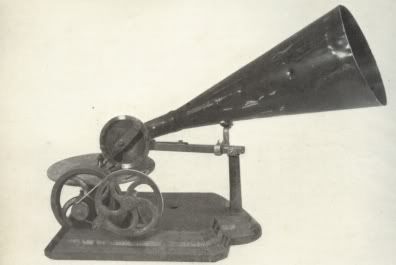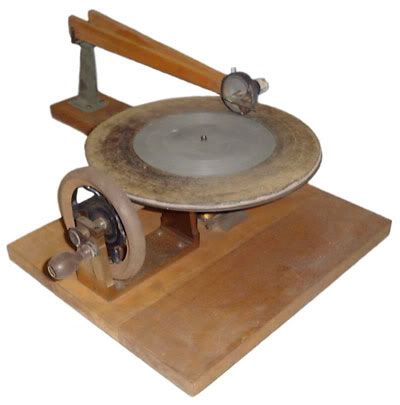Thomas Edison's Phonograph :

On December 4, 1877 Thomas Edison became the first person to ever record and play back the human voice. A band of tin foil was mounted on a cylinder, and the cylinder was turned via a hand crank during the recording and the playback. Edison turned the crank and spoke the first recorded words, "Mary had a little lamb, its fleece was white as snow, and everywhere that Mary went, the lamb was sure to go."
First Sound Recording Ever in 1877
Thomas Edison (1877) : Mary Had a Little Lamb (7 sec) :
The sound-waves focussed onto the diaphragm caused it to vibrate, which in turn caused the stylus to vary the pressure on the tinfoil. As the drum rotated and moved across the stylus a groove was embossed in the tinfoil consisting of undulations approximating the pressure patterns of the sound-waves. Playback involved placing the stylus at the beginning of the groove made during recording, and winding the cylinder along once again. The undulations in the tinfoil caused the stylus to move in and out, and so the diaphragm to vibrate, which in turn moved the air in the mouthpiece, thus recreating the sound.
Edison's Wax Cylinders (imagine carrying this, for one song):

After inventing the very first successful audio recording device, Thomas Edison got side tracked and didn't get back to developing the phonograph for about another 10 years. By that time, his patents had expired and others started taking interest in the invention. Meanwhile, as the phonograph was being developed, a German immigrant by the name of Emile Berliner, settled in the city of Washington D C, took an interest in the recording technology. His technology was very similar. But instead of using a cylinder, Berliner used a flat recording disc and a stylus which cut a spiral groove while the stylus in the cylinder moved up and down in vertical cut recording format to record the actual audio.
Emile Berliner's Gramophone recording device :

In the summer of 1887, Berliner recorded in his own voice, "Twinkle, Twinkle Little Star". In 1888 he filed and patented a talking machine which also recorded and played back sound. He called his talking machine the Gramophone. The main advantage of a flat medium disc, was that thousands of records could be inexpensively pressed from one master. The Gramophone soon became the worldwide standard.
First Sound Recording Ever on a Flat Disc in 1887
Emile Berliner (1887) : Twinkle Twinkle Little Star (22 sec) :
Emile Berliner's Gramophone player :

The first Indian voice was recorded in London in the year 1898. In 1901, The Gramophone and Typewriter Company, which later became HMV and then EMI, sent Will and Fred Gaisberg (originally Berliner's agents), on a series of tours, first in Europe, but soon extending to India. The first sound recording in India was performed in 1902. As we now realise, India did not lag much behind in the age when most of its population travelled on bullock carts. A sure sign of the recognition India got, as a huge market, even in those early days of sound recordings.



No comments:
Post a Comment